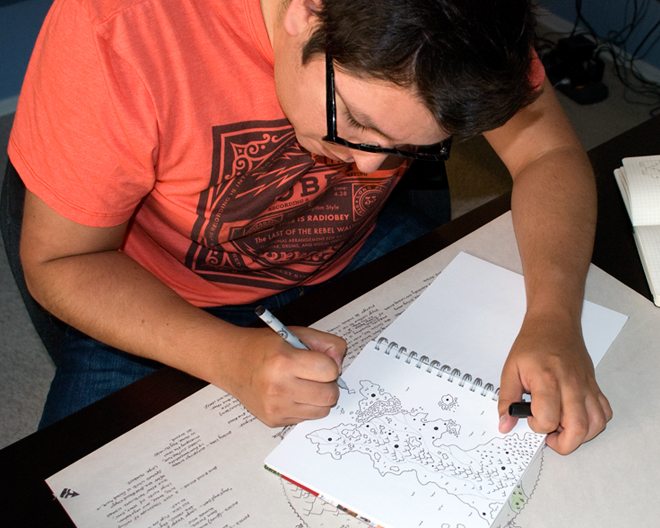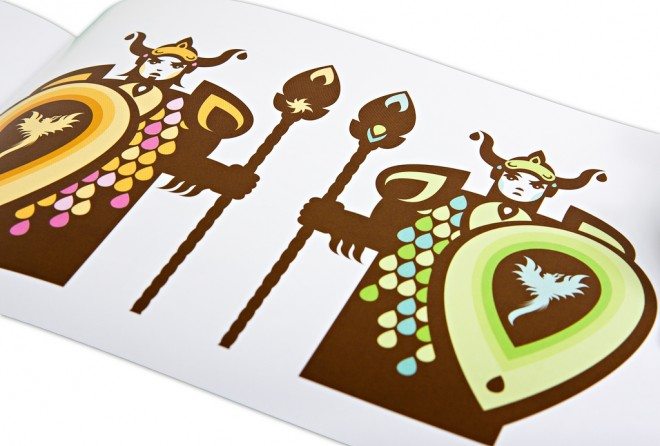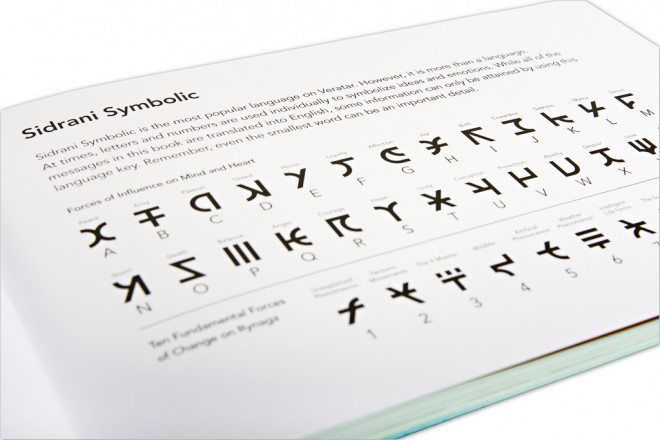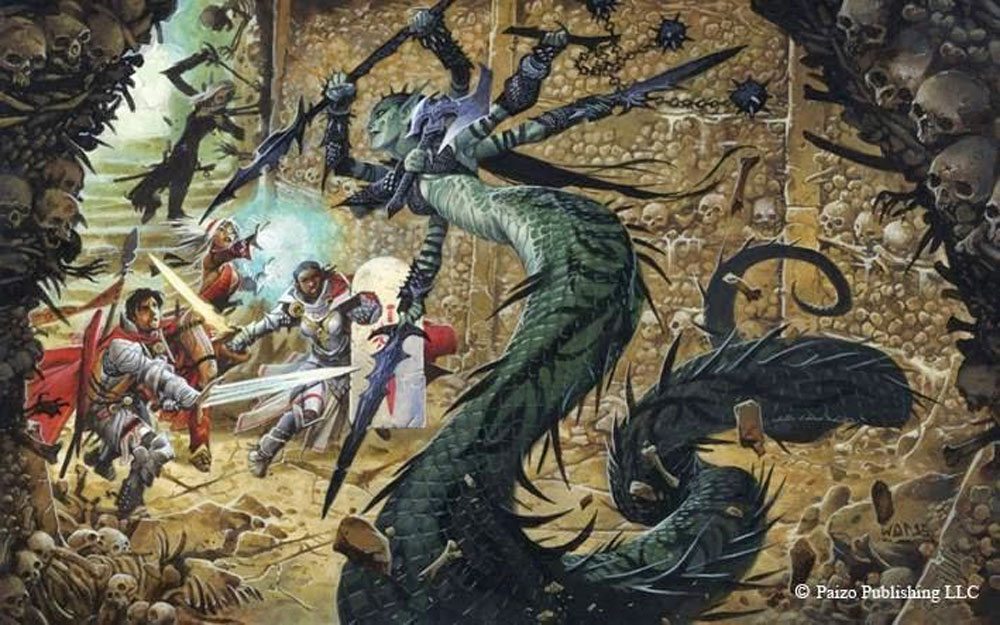
I recently reviewed Iconica, a gorgeous strategy game by Eric Torres, and I mentioned that the game itself is only a small part of the world Torres has been creating. Aside from the game, there is also a book, Prelude, which tells a bit of the story about the World of Rynaga. Available from his Etsy shop for $24, Prelude is told through a series of postcards from Solan Sylis as he travels across the land of Veratar. The postcards are illustrated with the same types of graphics that are found in Iconica and introduce the reader to many of the concepts and peoples that will find their way into the game. (And a bonus for those of you who have Iconica: the book also ships with a bonus card, the Kril Assassin, which is not available separately at this point.)
I asked Torres about his inspirations, his decision to self-publish, and his plans for the future.

GeekDad: Can you give us an overview of the fictional world of Rynaga?
Eric Torres: As a planet, Rynaga (rin-ah-gah) is more than 10 times the size of Earth. In fact, a great majority of this world is still untouched by civilization. Like our Earth, the flora and fauna of this world rely on a fragile balance to thrive, from tiny microorganisms to gigantic living creatures. The peoples of Rynaga are naturally intelligent, industrious, and noble. They had never known distrust, conflict, or war … until the Sarion came.
It’s been decades since Sarion settlers arrived on Rynaga. This race of humanoids had to adapt to their new home. Upon their arrival, Sarion technologies were rendered useless by strange energy fields present within Rynaga’s atmosphere. Many Sarion settlers did not survive the early days of their colonization. But the Sarion are a persistent and resourceful race. Over the years they became a great empire, one that is now eager to expand its borders. However, while resourceful and inventive, the Sarion do not understand Rynaga as well as they think they do.
Descriptively speaking, I’m infusing Rynaga with echoes of medieval fantasy. However, there is a bit of sci-fi present, as the Sarion look for ways to resurrect their brand of science and technology on Rynaga.
GD: What inspired you to create the World of Rynaga?
ET: If there was one single thing that’s inspired me to create Rynaga, it’s been my love of books. As a kid I was always reading. I read the works of Tolkien, Lewis Carroll, Kipling, Homer, Frank Baum, Arthur C. Clarke, Frank Herbert, Sir Arthur Conan Doyle, Tennyson, J.M. Barrie, Jack London, and others.
As I became an adult, my career involved more and more writing, illustrating, and designing. So building my own fictional universe seemed like a natural progression. It’s a very satisfying project. I’ve found a way to create content as opposed to living a life focused only on consuming content.

GD: How long have you been working on the World of Rynaga (both the book and the game)?
ET: I started the Rynaga project back in 2004, which seems like only yesterday. I created the galaxy Rynaga belonged to, its solar system, planetary data, and 12 major races along with their histories and cultures. By the end of 2006, it took about 33 sketchbooks and notepads to capture all of my initial ideas. (I think my wife thought I had gone crazy at that point!)
Once I had a “big picture” understanding of Rynaga, I started imagining other things such as creatures, landmarks, plant-life, weather cycles, and cities. All of this was necessary to build the foundation for story-telling. In the end, it’s taken me six years to get to where I am now – the beginning. Happily, my wife isn’t so worried about me now. In fact, she manages a great deal of my resources and keeps me focused on getting things done. She’s my greatest supporter. (100 husband-points please!)
GD: What is your day job, and how much overlap is there between that and the Rynaga project?
ET: Currently, I work as an in-house designer/art director for a small financial institution here in Phoenix. The work I do at my day job has taught me a great deal about marketing, communication, and project management. It’s taught me how to maintain great client and vendor partnerships. I’ve built strong relationships with great colleagues who believe in me and trust in my ideas.
In 2008 I started my own company called Specimen, through which I publish my merchandise. I keep my personal projects and my day job separate. Yet, as a non-linear thinker there are days when the gravitational pull between Reality and Rynaga is tremendous. Using my imagination is an inherent need, something that I must do daily. So at work I draw, write, or read on my breaks. This is how I keep close to Rynaga and its fiction on a daily basis.
GD: Which came first, the book or the game?
ET: My first book, Prelude, was released at the end of 2007. The game, Iconica, was released early in 2009. Both of these projects were developed side by side beginning in 2005. This was so that I could maintain a good understanding of what it would take to have the characters and peoples of my stories, jump from the book to the game.
GD: What are some of your influences, both artistically and thematically?
ET: I admire Scandinavian folk art and wood cuts, ancient Greek art and sculptures, Asian pop culture, Egyptian hieroglyphics, Mayan stone carvings and the art and architecture of the European Renaissance. From an artistic standpoint, I’m trying to cultivate an art and design style that people of many cultures can identify with.
Thematically, the stories set in Rynaga are about people we all may know – the adventurous traveler, the quiet contemplator, the troubled romantic and the determined soul. I’d like to think that most humans can identify with characters who seek something more important than themselves, like justice, love, beauty, or truth.
The lines between fiction and reality have always been blurry to me. (Too much classic fiction as a kid? Maybe.) At some point in our lives, we may have a boss who plays the part of a villain, a trusted friend who is our hero, or a lost love who still plays the role of our muse. Some seem to live the fairy-tale life, while others bravely battle oppression in a distant land. Regardless, I think we all strive to believe that our lives are stories worth telling. These are some of the ideas that influence my work.
GD: Do you have kids, and have you gotten them involved in Iconica in any way?
ET: I have a son who is 12 years old. He’s a budding musician and a good artist as well. It’s crazy to think that when I started the Rynaga project he was only seven years old. We spend a good amount of time playing video games and board games together.
My son enjoys playing Iconica and he’s given me lots of good advice. Whenever I write actions for characters or propose an update to the Iconica rules, I find myself asking him for his thoughts. When things don’t make sense, he’s happy to tell me. As he gets older, the value of his feedback will only increase.
GD: Why did you decide to self-publish, and are you glad you did?
ET: Well, that was a big decision. It really came down to not wanting to wait around for someone to give me permission to do something I really wanted to do. I knew I had the skill, time, energy, support, and resources to get things going, so I just started. I understand that some would rather wait for venture capitalists or “king-makers” to approach them with investment money before beginning a project. Yet, for most people that never happens. Waiting around for a golden ticket is a flawed strategy. There’s no substitute for getting ideas done, even if it’s just a little bit at a time.
Ultimately, I intend to retain ownership of my intellectual property, which is why I started Specimen Design. By publishing things through my own legal entity, I’m able to ensure that I can see more benefits for my hard work. So far, I’ve been very happy with my decision to self-publish. Without doing this, I don’t think anything would have happened and Rynaga would be nothing more than a lost dream.
GD: Would you consider working with an established game publisher if they expressed interest in Iconica?
ET: I would be short-sighted to not consider such a thing. As an small indie creator, my time is divided and this slows down my progress at times. Each day I also have to battle obscurity. When people don’t know you exist, they can’t be interested in your work. So, if I had the help of an established game publisher when it came to marketing for instance, I could spend more time on delivering ideas and thereby accomplish much more, much faster.
However, the reality is that Iconica is not just a game. It’s an idea based on a fictional world that I have created with a long-term vision. I’m the beating heart of this project, from concept to production. I’m connecting with Iconica‘s players, I’m responding to their inquiries, I’m listening to their feedback through social media channels, I’m planning for the future of Rynaga as a franchise, and ultimately I’m responsible for generating the ideas. I take all of this very personally and for as much fun as I have, I take it seriously.
In the end, no matter what scale Iconica is produced on, I’m determined to stay personable and accessible as the creator of this project. My actions will continue to show that I’m focused on creating a consistently enjoyable experience for Iconica players.
GD: I noticed at the back of Prelude you mention the Vormator Project. Could you tell me a little bit more about that?
ET: I participated in the Vormator project in 2007. In this project, participants were faced with the challenge of using just eight geometric shapes to create a work of graphic art. (In fact, they released a book featuring a select portion of the submissions if anyone is interested.) The Vormator project was a practical way of highlighting the value of self-imposed limitations, which help to focus a visual (or even written) concept and create a more compelling result. I make it a point to use these principles in my approach to design commercially and for my own projects.

GD: What’s next in the world of Rynaga? I see you have some new cards coming out for the game and others listed as “in development”; is there more storytelling planned as well?
ET: By the end of this spring, I plan to wrap up the first series of Iconica characters and begin work on a brand new series of cards. While the rules for Iconica will remain the same, I want to continue growing the diversity of archetypes found in the game. We have literally brain-stormed hundreds of cards – from humanoids and legendary characters to beasts, insects, and pets.
While there is an all-encompassing epic story to tell about Rynaga, I’m currently working on some side stories that will feature original art and create new opportunities for Iconica tie-ins. There are other exciting possibilities that I am exploring as well, yet it’s important to me to not lose focus on my current efforts.
As for the rest of my plans, that might be opening the “mystery box” up a bit too much!
Thanks to Eric Torres for speaking with us and providing a copy of Prelude for review purposes. All images from Eric Torres, used with permission.
Iconica: Not Just Another Pretty Face
Eric Torres’ Rynaga blog
Follow Eric Torres on Twitter



